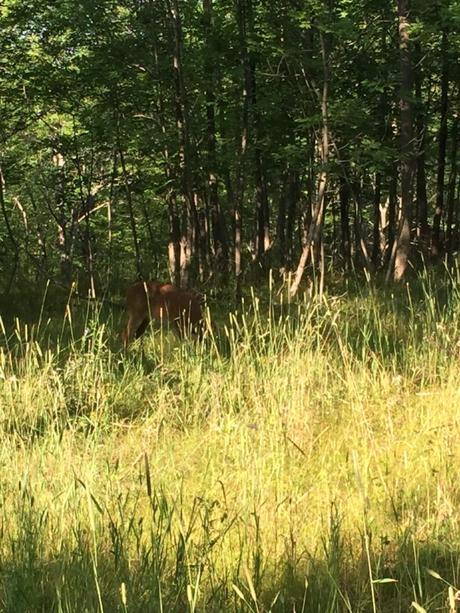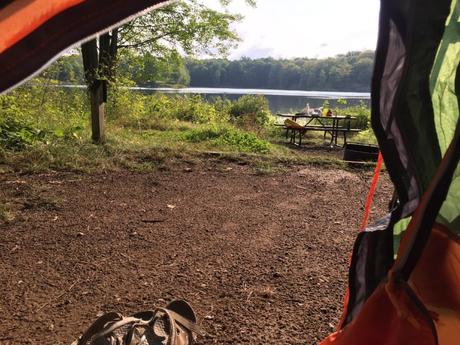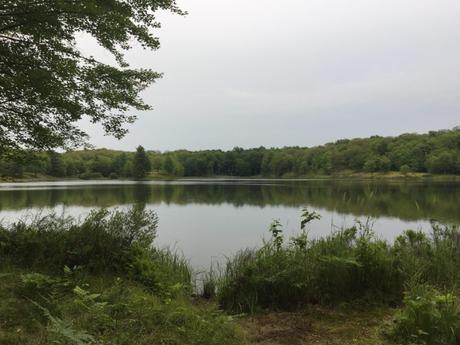
It's nearly 5 p.m. by the time I arrive at the access point. I'm so concerned I won't get to my site before dark, I forget to ask all of my questions when I check in at the park office.
Where's a good place to go swimming near my site? Are there any boil water advisories? Have any bears been spotted in the area? Are any areas of the trail swamped out?I curse myself for forgetting to ask these questions as I amble through the park, mud squelching underfoot in a swampy area as I catch the tail end of a massasauga rattlesnake slithering in the wet grass beside me. Noting to pay closer attention to where I'm walking, I continue on the trail.
Frontenac is an Ontario Provincial Park located roughly halfway between Toronto and Ottawa. On the edge of the Canadian Shield, the park is great for wildlife viewing, canoeing, hiking and fishing. It's one of Ontario's year-round parks and has snowshoe and cross-country ski trails in winter. Frontenac used to be home to a mining village before being turned into a park and hikers may see signs of old log cabins from previous habituation.
Sun glitters on the green leaves and grey tree parks as I walk, passing only a couple of other people en route. Maybe I won't be the only one late to my campsite.
The sky is turning pink and I start walking faster until I notice something moving in my periphery. I turn to see a white-tailed deer, munching on some grass, on the side of the trail.

I stop walking and take a few deep breaths, looking at the creature and snapping a couple of photos.
I remind myself that I'm making good time and should be at my campsite with plenty of time to set up before dark. I also remind myself I have a good flashlight, just in case. I don't want to rush through and miss enjoying these spectacular moments.
I take a slower pace as I continue along the trail, noticing the scenery changing around me from coniferous forest to maple, to open fields, passing by lakes, streams and portage trails.
When I get to my campsite, the sun has barely lowered in the sky. I watch the pink reflection of the sunset glittering off the lake and then get to work setting up. I'm pleased to find there's a food locker (all the sites at Frontenac are equipped with one) so I don't have to worry about finding a tree to hang my food-a necessary step in keeping food safe from bears and critters. There's also a not-so-pleasant-smelling outhouse shared with a few other nearby campsites.
I pitch my tent on a flat area and get out my camp stove to cook a well-earned dinner of lentil curry.

As the stars start to come out, I build a campfire, resting my tired legs and gazing up at the stars.
My second day of the trip feels luxurious. I'm staying at the same site so there's no need to trek anywhere too far away. I explore some of the surrounding lakes until I find a place to swim and wash away the sweat and grime of the hike of the day before. I wander around empty trails and spot even more white-tailed deer.
I build an evening fire. I watch rain clouds roll in. I fall asleep to the patter of rain and rustling leaves in my tent.
When I walk out the following morning, I'm no longer in a rush. Even just two days in the wilderness has reminded me to slow down and to watch where I'm walking, not only for dangers like rattlesnakes or to avoid a twisted ankle but because I've remembered the joys of going slow.

Having lived much of the past year and a half through online notifications, immersing myself in nature reminded me to take a few deep breaths, that having nothing to do for a day is a joy and that noises outside the tent are usually less scary than they sound.
Frontenac Provincial Park is a backcountry-only park but is a great spot for those new to the backcountry. The park is relatively small and has decent cell phone reception, for the most part. Sites are equipped with tent pads, food lockers and outhouses, and both paddle and hiking routes range from a short 2-3 kilometer trek to longer 15-20 kilometer journeys from the campsites. Reservations are needed and can be made on the Ontario Parks website.

